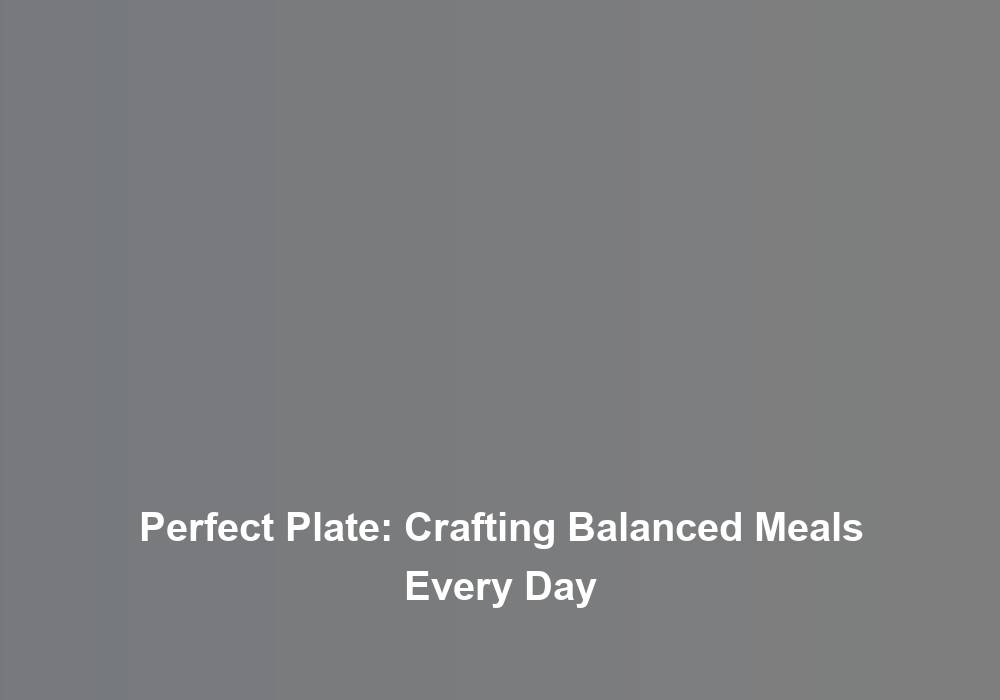Perfect Plate: Crafting Balanced Meals Every Day
Crafting balanced meals every day is a goal many strive for, but it can be challenging to consistently achieve. You may find yourself wondering how to ensure that your plate is not only delicious but also nutritionally sound. The key lies in understanding the concept of the Perfect Plate and how it can guide your meal preparation. By focusing on building a nutrient-dense base, incorporating lean proteins, adding colorful and fiber-rich vegetables, including healthy fats and whole grains, and balancing portions with moderation, you can create meals that not only satisfy your palate but also support your overall well-being. But how exactly can you put this concept into practice in your daily life?
Understanding the Perfect Plate Concept
When constructing a balanced meal, itG??s essential to understand the Perfect Plate Concept to ensure youG??re incorporating a variety of nutrients and food groups in appropriate proportions. Exploring portion control is a key aspect of this concept. By dividing your plate into sections for different food groups, you can easily visualize and manage portion sizes. For example, filling half your plate with colorful fruits and vegetables, one quarter with whole grains, and one quarter with lean proteins is a simple way to ensure balanced portions.
In addition to portion control, considering nutrient absorption strategies is crucial for optimizing the benefits of the food you consume. Pairing foods rich in non-heme iron, such as spinach or lentils, with vitamin C-rich foods like bell peppers or strawberries can enhance iron absorption. Similarly, consuming fat-soluble vitamins like A, D, E, and K with a source of healthy fats can aid in their absorption.
Understanding the Perfect Plate Concept empowers you to make informed choices about the foods you eat, ensuring a balanced intake of essential nutrients. By incorporating portion control and nutrient absorption strategies into your meal planning, you can maximize the nutritional value of each meal. This approach not only supports your physical well-being but also provides a sense of belonging to a community of individuals who prioritize health and wellness through mindful eating.
Building a Nutrient-Dense Base
After understanding the Perfect Plate Concept and the importance of portion control and nutrient absorption, the next step is to focus on building a nutrient-dense base for your meals. A nutrient-dense base provides essential vitamins, minerals, and macronutrients that are vital for your overall health and well-being. Here are some practical steps to help you build a nutrient-dense base for your meals:
-
Meal prep: Spend some time planning and preparing your meals in advance. This not only saves time during busy days but also allows you to incorporate a variety of nutrient-dense foods into your meals.
-
Follow nutritional guidelines: Refer to established nutritional guidelines to ensure that your meals are balanced and provide the necessary nutrients. These guidelines can help you make informed choices about the types and proportions of foods to include in your meals.
-
Include a variety of colorful fruits and vegetables: Different colored fruits and vegetables provide a range of vitamins, minerals, and antioxidants. Aim to include a variety of colors in your meals to ensure you are obtaining a broad spectrum of nutrients.
-
Incorporate lean proteins and healthy fats: Choose lean sources of protein such as poultry, fish, beans, and legumes, and include healthy fats from sources like avocados, nuts, and olive oil. These macronutrients are essential for overall health and provide a sense of satiety.
Incorporating Lean Proteins
Incorporate lean proteins into your meals to support muscle health and provide essential nutrients for overall well-being. Lean protein sources like chicken, turkey, fish, tofu, legumes, and low-fat dairy are essential for a well-rounded diet. Including these in your meals can be achieved through various meal preparation techniques. Grilling, baking, or steaming lean meats and fish can help retain their natural flavors without adding excessive fats. When preparing tofu, marinating and then baking or grilling can enhance its taste and texture. Incorporating legumes such as lentils, chickpeas, and black beans into soups, salads, or stews can add a substantial protein boost to your meals.
When planning your meals, consider the protein content of each component. For example, if youG??re making a salad, adding grilled chicken or chickpeas can significantly increase the protein content. In stir-fries, incorporating tofu or lean cuts of meat can help balance the meal. Moreover, meal prepping can make it easier to incorporate lean proteins into your daily diet. Cook and portion lean proteins in advance, so theyG??re readily available to add to meals throughout the week. By making lean proteins a staple in your meals, you can ensure that youG??re providing your body with the essential nutrients it needs to thrive.
Adding Colorful and Fiber-Rich Vegetables
To ensure a well-rounded and nutritious meal, consider incorporating a variety of colorful and fiber-rich vegetables into your dishes. Adding vegetables not only enhances the visual appeal of your plate but also provides essential nutrients and fiber for your bodyG??s optimal function. Here are some practical tips to help you enjoy and benefit from incorporating colorful and fiber-rich vegetables into your meals:
-
Veggie Variety: Aim to include a diverse range of vegetables in different colors such as leafy greens, red peppers, purple eggplants, and orange carrots. Each color indicates the presence of specific vitamins, minerals, and antioxidants, so a colorful assortment ensures you benefit from a wide array of nutrients.
-
Fiber Focus: Opt for high-fiber vegetables like broccoli, Brussels sprouts, artichokes, and spinach. Fiber aids in digestion, helps maintain a healthy weight, and reduces the risk of chronic diseases. It also promotes a feeling of fullness, which can assist in managing portion control and overall calorie intake.
-
Creative Cooking: Experiment with various cooking methods such as roasting, grilling, steaming, or saut+?ing to bring out the natural flavors and textures of different vegetables. This can make your meals more enjoyable and appealing.
-
Meal Combinations: Mix and match different vegetables to create visually appealing and nutrient-rich combinations in salads, stir-fries, soups, and side dishes. This not only adds variety to your meals but also ensures you receive a broad spectrum of essential nutrients.
Incorporating these colorful and fiber-rich vegetables into your daily meals not only adds vibrancy and flavor but also provides numerous health benefits, contributing to your overall well-being.
Including Healthy Fats and Whole Grains
Now that weG??ve explored the benefits of incorporating colorful and fiber-rich vegetables into your meals, letG??s turn our attention to the significance of including healthy fats and whole grains in your diet for overall nutritional balance and well-being.
Healthy fats, such as those found in avocados, nuts, and olive oil, are essential for various bodily functions. They provide energy, aid in vitamin absorption, and support heart health. When it comes to healthy cooking, consider using olive oil for saut+?ing and salad dressings, and incorporating avocados and nuts into your meals as tasty sources of healthy fats.
Whole grains, like brown rice, quinoa, and whole wheat bread, offer a spectrum of nutrients including fiber, vitamins, and minerals. They can help manage weight, reduce the risk of chronic diseases, and promote digestive health. When meal planning, aim to make at least half of your grain choices whole grains. This could mean opting for whole grain pasta, choosing whole grain bread over refined white bread, or incorporating quinoa into your salads or stir-fries.
Incorporating healthy fats and whole grains into your meals doesnG??t have to be complicated. Small changes in your cooking and meal planning can make a big difference in your overall nutritional intake. By being mindful of these choices, youG??re taking proactive steps towards a balanced and nourishing diet.
Balancing Portions and Moderation
For optimal nutritional balance, itG??s important to be mindful of portion sizes and practice moderation in your meal choices. Portion control and moderation are key elements in maintaining a healthy and balanced diet. Here are some practical tips to help you balance your portions and practice moderation in your meals:
-
Portion control: Be mindful of portion sizes to avoid overeating. Use smaller plates, bowls, and glasses to help control portion sizes. Aim to fill half of your plate with vegetables, one-quarter with lean protein, and one-quarter with whole grains or starchy vegetables.
-
Meal planning: Plan your meals in advance to ensure balanced portions and moderation. Prepare and portion out meals and snacks ahead of time to avoid overeating. Incorporate a variety of nutrient-dense foods into your meal plan to support overall health and well-being.
-
Mindful eating: Pay attention to your bodyG??s hunger and fullness cues. Eat slowly and savor each bite, being mindful of the flavors and textures of your food. Avoid distractions, such as electronic devices, while eating to focus on your meal and prevent overeating.
-
Moderation: Enjoy your favorite foods in moderation. Allowing yourself occasional treats can help prevent feelings of deprivation and promote a sustainable approach to healthy eating. Practice mindful indulgence and savor small portions of your favorite treats without overdoing it.
Conclusion
So there you have it – the perfect plate for crafting balanced meals every day. Just remember, itG??s all about nutrient density, lean proteins, colorful veggies, healthy fats, and whole grains. And donG??t forget to balance those portions and practice moderation – because who doesnG??t love a good challenge? Now go forth and conquer your meals with the power of the perfect plate!







